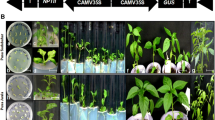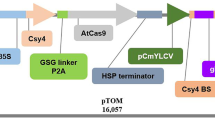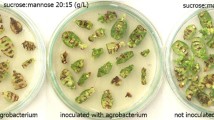Abstract
In this work, Potato virus Y (PVY) resistant potatoes were generated using an environmentally safe construct. For this purpose, a ‘shooter’ mutant Agrobacterium-based transformation system was used. The isopentenyl transferase gene (ipt) present on the Ti plasmid of ‘shooter’ strains enhances shoot regeneration and can be used as a phenotypic selection marker. The introduced marker-free binary vector carried a hairpin construct derived from the coat protein gene of PVY-NTN strain in order to induce gene silencing. Transformation resulted in high regeneration rates (1.4–5.7 shoots per explant). With pre-selection for the ipt + phenotype the transformation frequency was 24–53%, while without selection 12–28% of the shoots were PCR positive. The presence of the transgene was verified by Southern hybridization. In 16 of 31 challenged transformant lines PVY could be detected neither by RT-PCR nor by back inoculation. A 62.5% of these resistant lines proved to be also ipt-free. This transformation system was reproducible in four potato cultivars, suggesting that it could easily be adapted for other species.





Similar content being viewed by others
Abbreviations
- CP:
-
Coat protein
- gus :
-
Beta-glucuronidase gene
- hpt :
-
Hygromycin phosphotransferase gene
- ipt :
-
Isopentenyl transferase gene
- nptII :
-
Neomycin phosphotransferase gene
- PTGS:
-
Post-transcriptional gene silencing
- PVX:
-
Potato virus X
- PVY:
-
Potato virus Y
- YCP:
-
The coat protein region of the Potato virus Y genome used in this paper
References
Aaziz R, Tepfer M (1999) Recombination in RNA viruses and in virus-resistant transgenic plants. J Gen Virol 80:1339–1346
Barry GF, Rogers SG, Fraley RT, Brand L (1984) Identification of a cloned cytokinin biosynthetic gene. Proc Natl Acad Sci USA 81:4776–4780
Beczner L, Horváth J, Romhányi I, Förster H (1984) Studies on the etiology of tuber necrotic ringspot disease in potato. Potato Res 27:339–352
Chilton M-D, Curier TC, Farrand SK, Bendich AJ, Gordon MP, Nester EW (1974) Agrobacterium tumefaciens DNA and PS8 bacteriophage DNA not detected in crown gall tumors. Proc Natl Acad Sci USA 71:441–452
Church GM, Gilbert W (1984) Genomic sequencing. Proc Natl Acad Sci USA 81:1991–1995
de Vetten N, Wolters AM, Raemakers K, van der Meer I, ter Stege R, Heeres E, Heeres P, Visser R (2003) A transformation method for obtaining marker-free plants of a cross-pollinating and vegetatively propagated crop. Nat Biotechnol 21:439–442
Farinelli L, Malnoë P, Collet GF (1992) Heterologous encapsidation of potato virus Y strain O (PVY-O) with the transgene protein of PVY strain N (PVY-N) in Solanum tuberosum cv. Bintje. Biotechnology 10:1020–1025
Fladung M (1999) Gene stability in transgenic aspen (Populus). I. Flanking DNA sequences and T-DNA structure. Mol Gen Genet 260:574–581
Gargouri-Bouzid R, Jaoua L, Mansour R B, Hathat Y, Ayadi M, Ellouz R (2005) PVY resistant transgenic potato plants (cv. Claustar) expressing the viral coat protein. J Plant Biotechnol 3:1–5
Holsters M, Silva B, van Vliet F, Genetello C, de Block M, Dhaese P, Depicker A, Inzé D, Engler R, Villaroel R, van Montagu M, Schell J (1980) The functional organization of the nopaline A. tumefaciens plasmid pTiC58. Plasmid 3:212–230
Höfgen R, Willmitzer L (1988) Storage of competent cells for Agrobacterium transformation. Nucleic Acids Res 20:9877
Huang S, Gilbertson LA, Adams TH, Malloy KP, Reisenbigler EK, Birr DH, Snyder MW, Zhang Q, Luethy MH (2004) Generation of marker-free transgenic maize by regular two-border Agrobacterium transformation vectors. Transgenic Res 13:451–461
Johansen E (1996) Intron insertion facilitates amplification of cloned virus cDNA in Escherichia coli while biological activity is reestablished after transcription in vivo. Proc Natl Acad Sci USA 93:12400–12405
Kollar A, Thole V, Dalmay T, Salamon P, Balazs E (1993) Efficient pathogen-derived resistance induced by integrated potato virus Y coat protein gene in tobacco. Biochimie 75:623–629
Malnoë P, Farinelli L, Collet G, Reust W (1994) Small-scale field tests with transgenic potato, cv Bintje, to test the resistance to primary and secondary infections with potato virus Y. Plant Mol Biol 25:963–975
Mäki-Valkama T, Pehu T, Santala A, Valkonen JPT, Koivu K, Lehto K, Pehu E (2000) High level of resistance to potato virus Y by expressing P1 sequence in antisense orientation in transgenic potato. Mol Breed 6:95–104
Mihálka V, Balázs E, Nagy I (2003) Binary transformation systems based on ‘shooter’ mutants of Agrobacterium tumefaciens: a simple, efficient and universal gene transfer technology that permits marker gene elimination. Plant Cell Rep 21:778–784
Mihálka V, Fári M, Szász A, Balázs E, Nagy I (2000) Optimised protocols for efficient plant regeneration and gene transfer in pepper (Capsicum annuum L.) J Plant Biotechnol 2:143–149
Miller M, Tagliani L, Wang N, Berka B, Bidney D, Zhao ZY (2002) High efficiency transgene segregation in co-transformed maize plants using an Agrobacterium tumefaciens 2 T-DNA binary system. Transgenic Res 11:381–396
Missiou A, Kalantidis K, Boutla A, Tzortzakaki S, Tabler M, Tsagris M (2004) Generation of transgenic potato plants highly resistant to potato virus Y (PVY) through RNA silencing. Mol Breed 14:185–187
Murashige T, Skoog F (1962) A revised medium for rapid growth and bioassays with tobacco tissue cultures. Physiol Plant 15:473–497
Newell CA, Rozman R, Hinchee MA, Lawson EC, Haley L, Sanderson P, Kaniewski W, Tumer NE, Horsch RB, Fraley RT (1991) Agrobacterium-mediated transformation of Solanum tuberosum L. cv. ‘Russet Burbank’. Plant Cell Rep 10:30–34
Nie X, Singh RP (2002) Probable geographical grouping of PVYN and PVYNTN based on sequence variation in P1 and 5′-UTR of PVY genome and methods for differentiating North American PVYNTN. J Virol Methods 103:145–156
Risseeuw E, Franke-van Dijk ME, Hooykaas PJ (1997) Gene targeting and instability of Agrobacterium T-DNA loci in the plant genome. Plant J 11:717–728
Rommens MC, Humara MJ, Ye J, Yan H, Richael C, Zhang L, Perry R, Swords K (2004) Crop improvement through modification of the plant's own genome. Plant Physiol 135:421–431
Sharp PJ, Kreis M, Shewry PR, Gale MD (1988) Location of beta-amylase sequences in wheat and its relatives. Theor Appl Genet 75:286–290
Smith HA, Powers H, Swaney S, Brown C, Dougherty WG (1995) Transgenic potato virus Y resistance in potato: evidence for an RNA-mediated cellular response. Phytopathology 85:864–870
Smith NA, Singh SP, Wang MB, Stoutjesdijk PA, Green AG, Waterhouse PM (2000) Gene expression: total silencing by intron-spliced hairpin RNAs. Nature 407:319–320
Srivastava V, Vasil V, Vasil IK (1996) Molecular characterization of the fate of transgenes in transformed wheat (Triticum aestivum L.). Theor Appl Genet 92:1031–1037
Varrelmann M, Palkovics L, Maiss E (2000) Transgenic or plant expression vector-mediated recombination of Plum pox virus. J Virol 74:7462–7469
Vervliet G, Holsters M, Teuchy H, van Montagu M, Schell J (1975) Characterization of different plaque-forming and defective temperate phages in Agrobacterium strains. J Gen Virol 26:33–38
Weigel D, Glazebrook J (2002) Arabidopsis: a laboratory manual. Cold Spring Harbor Laboratory Press, Cold Spring Harbor, NY, pp 165–166
Yoder I, Goldsbrough P (1994) Transformation systems for generating marker-free transgenic plants. Biotechnology 12:263–267
Acknowledgements
We are grateful to Dr. Zsófia Bánfalvi and Dr. Brigitta Dudás for critical reading and editing the manuscript, to Mihály Kondrák and Apor Jeney for their help with the Southern analysis. This work was supported by the Hungarian Széchenyi NKFP-4/0023 grant (“Potato competitiveness”) and the Hungarian OTKA Science School (TS 447778). L. Palkovics was the recipient of a Bolyai scholarship (Hungarian Academy of Sciences).
Author information
Authors and Affiliations
Corresponding author
Additional information
Communicated by D. Dudits
Rights and permissions
About this article
Cite this article
Bukovinszki, Á., Divéki, Z., Csányi, M. et al. Engineering resistance to PVY in different potato cultivars in a marker-free transformation system using a ‘shooter mutant’ A. tumefaciens . Plant Cell Rep 26, 459–465 (2007). https://doi.org/10.1007/s00299-006-0257-8
Received:
Revised:
Accepted:
Published:
Issue Date:
DOI: https://doi.org/10.1007/s00299-006-0257-8




